Comprehensively Profiling the Chromatin Architecture of Tissue Restricted Antigen Expression in Thymic Epithelial Cells Over Development
- PMID: 30283453
- PMCID: PMC6156148
- DOI: 10.3389/fimmu.2018.02120
Comprehensively Profiling the Chromatin Architecture of Tissue Restricted Antigen Expression in Thymic Epithelial Cells Over Development
Abstract
Thymic epithelial cells (TEC) effect crucial roles in thymopoiesis including the control of negative thymocyte selection. This process depends on their capacity to express promiscuously genes encoding tissue-restricted antigens. This competence is accomplished in medullary TEC (mTEC) in part by the presence of the transcriptional facilitator AutoImmune REgulator, AIRE. AIRE-regulated gene transcription is marked by repressive chromatin modifications, including H3K27me3. When during TEC development these chromatin marks are established, however, remains unclear. Here we use a comprehensive ChIP-seq dataset of multiple chromatin modifications in different TEC subtypes to demonstrate that the chromatin landscape is established early in TEC differentiation. Much of the chromatin architecture found in mature mTEC was found to be present already over earlier stages of mTEC lineage differentiation as well as in non-TEC tissues. This was reflected by the fact that a machine learning approach accurately classified genes as AIRE-induced or AIRE-independent both in immature and mature mTEC. Moreover, analysis of TEC specific enhancer elements identified candidate transcription factors likely to be important in mTEC development and function. Our findings indicate that the mature mTEC chromatin landscape is laid down early in mTEC differentiation, and that AIRE is not required for large-scale re-patterning of chromatin in mTEC.
Keywords: AIRE; chromatin immunoprecipitation; histone modifications; thymic epithelial cells; tissue restricted antigen.
Figures
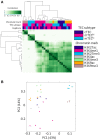

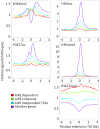
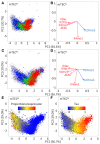
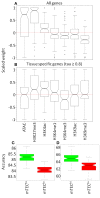
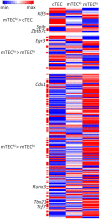
Similar articles
-
Population and single-cell genomics reveal the Aire dependency, relief from Polycomb silencing, and distribution of self-antigen expression in thymic epithelia.Genome Res. 2014 Dec;24(12):1918-31. doi: 10.1101/gr.171645.113. Epub 2014 Sep 15. Genome Res. 2014. PMID: 25224068 Free PMC article.
-
Aire knockdown in medullary thymic epithelial cells affects Aire protein, deregulates cell adhesion genes and decreases thymocyte interaction.Mol Immunol. 2016 Sep;77:157-73. doi: 10.1016/j.molimm.2016.08.003. Epub 2016 Aug 8. Mol Immunol. 2016. PMID: 27505711
-
Sequential phases in the development of Aire-expressing medullary thymic epithelial cells involve distinct cellular input.Eur J Immunol. 2008 Apr;38(4):942-7. doi: 10.1002/eji.200738052. Eur J Immunol. 2008. PMID: 18350550
-
Update on Aire and thymic negative selection.Immunology. 2018 Jan;153(1):10-20. doi: 10.1111/imm.12831. Epub 2017 Sep 26. Immunology. 2018. PMID: 28871661 Free PMC article. Review.
-
Single-cell sequencing has revealed a more complex array of thymic epithelial cells.Immunol Lett. 2024 Oct;269:106904. doi: 10.1016/j.imlet.2024.106904. Epub 2024 Aug 6. Immunol Lett. 2024. PMID: 39117004 Review.
Cited by
-
Transcriptomic diversity in human medullary thymic epithelial cells.Nat Commun. 2022 Aug 2;13(1):4296. doi: 10.1038/s41467-022-31750-1. Nat Commun. 2022. PMID: 35918316 Free PMC article.
-
Indispensable epigenetic control of thymic epithelial cell development and function by polycomb repressive complex 2.Nat Commun. 2021 Jun 24;12(1):3933. doi: 10.1038/s41467-021-24158-w. Nat Commun. 2021. PMID: 34168132 Free PMC article.
-
Transcriptional and epigenetic regulation in thymic epithelial cells.Immunol Rev. 2022 Jan;305(1):43-58. doi: 10.1111/imr.13034. Epub 2021 Nov 8. Immunol Rev. 2022. PMID: 34750841 Free PMC article. Review.
-
Thymocytes trigger self-antigen-controlling pathways in immature medullary thymic epithelial stages.Elife. 2022 Feb 21;11:e69982. doi: 10.7554/eLife.69982. Elife. 2022. PMID: 35188458 Free PMC article.
-
Thymic epithelial cells co-opt lineage-defining transcription factors to eliminate autoreactive T cells.Cell. 2022 Jul 7;185(14):2542-2558.e18. doi: 10.1016/j.cell.2022.05.018. Epub 2022 Jun 16. Cell. 2022. PMID: 35714609 Free PMC article.
References
-
- Sansom SN, Shikama N, Zhanybekova S, Nusspaumer G, Macaulay IC, Deadman ME, et al. . Population and single cell genomics reveal the Aire-dependency, relief from Polycomb silencing and distribution of self-antigen expression in thymic epithelia. Genome Res. (2014) 24:1918–31. 10.1101/gr.171645.113 - DOI - PMC - PubMed
Publication types
MeSH terms
Substances
Grants and funding
LinkOut - more resources
Full Text Sources
Molecular Biology Databases

